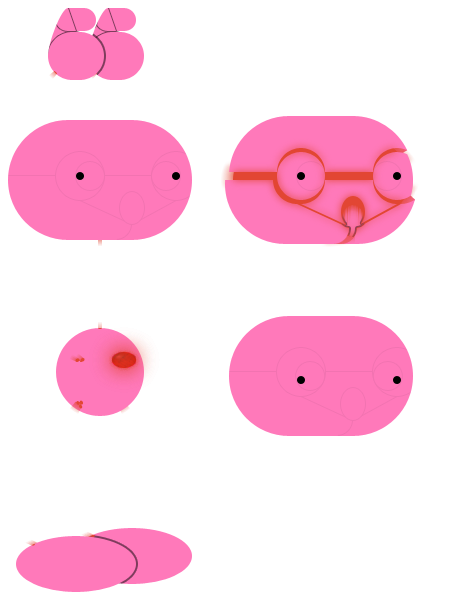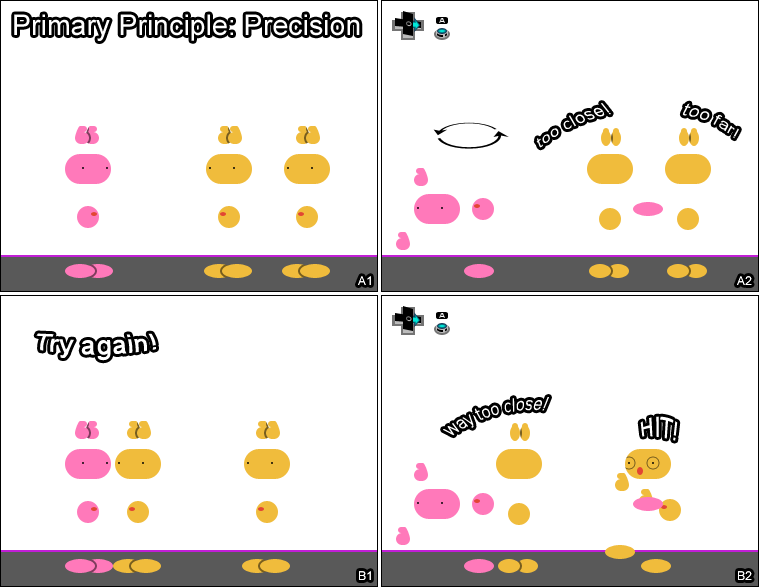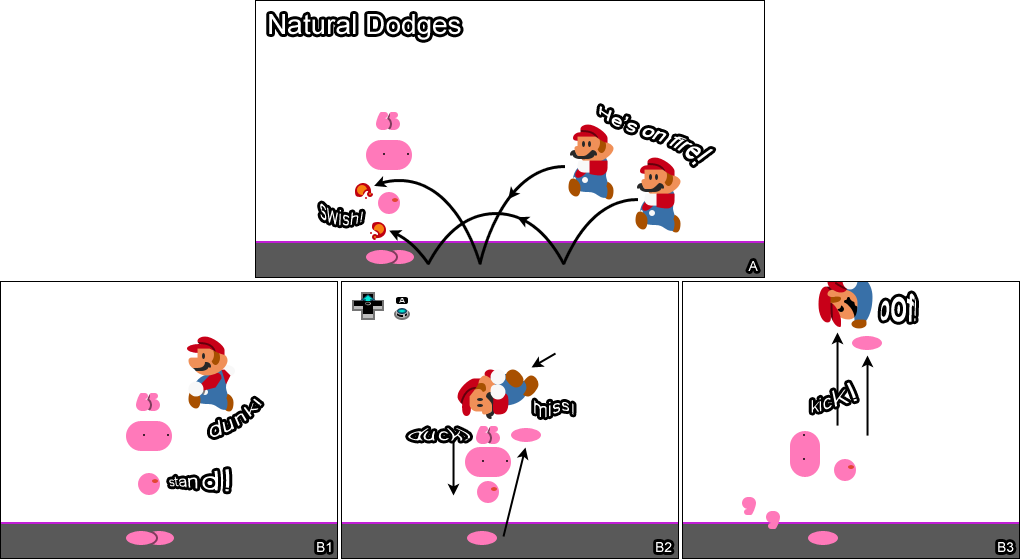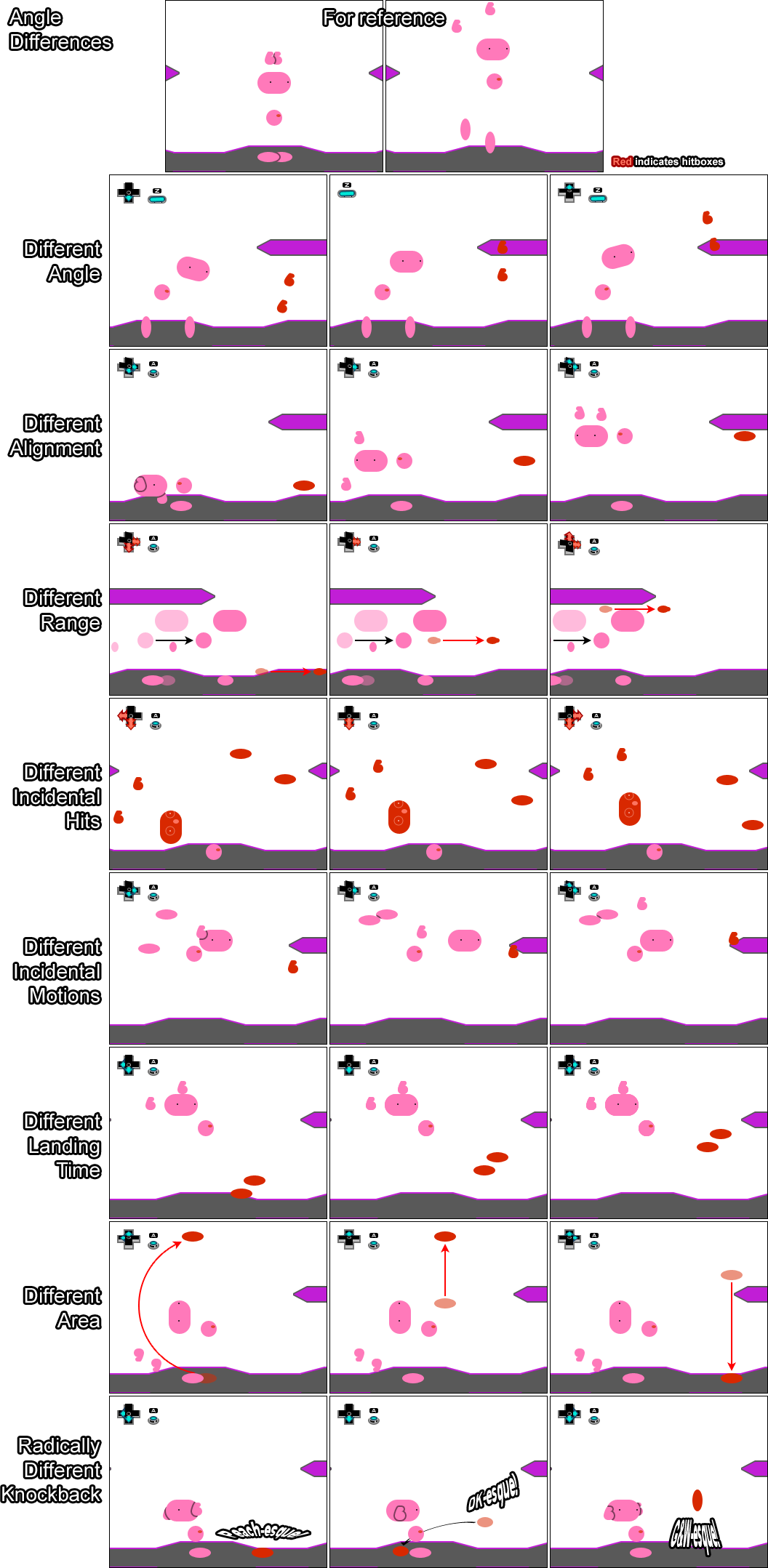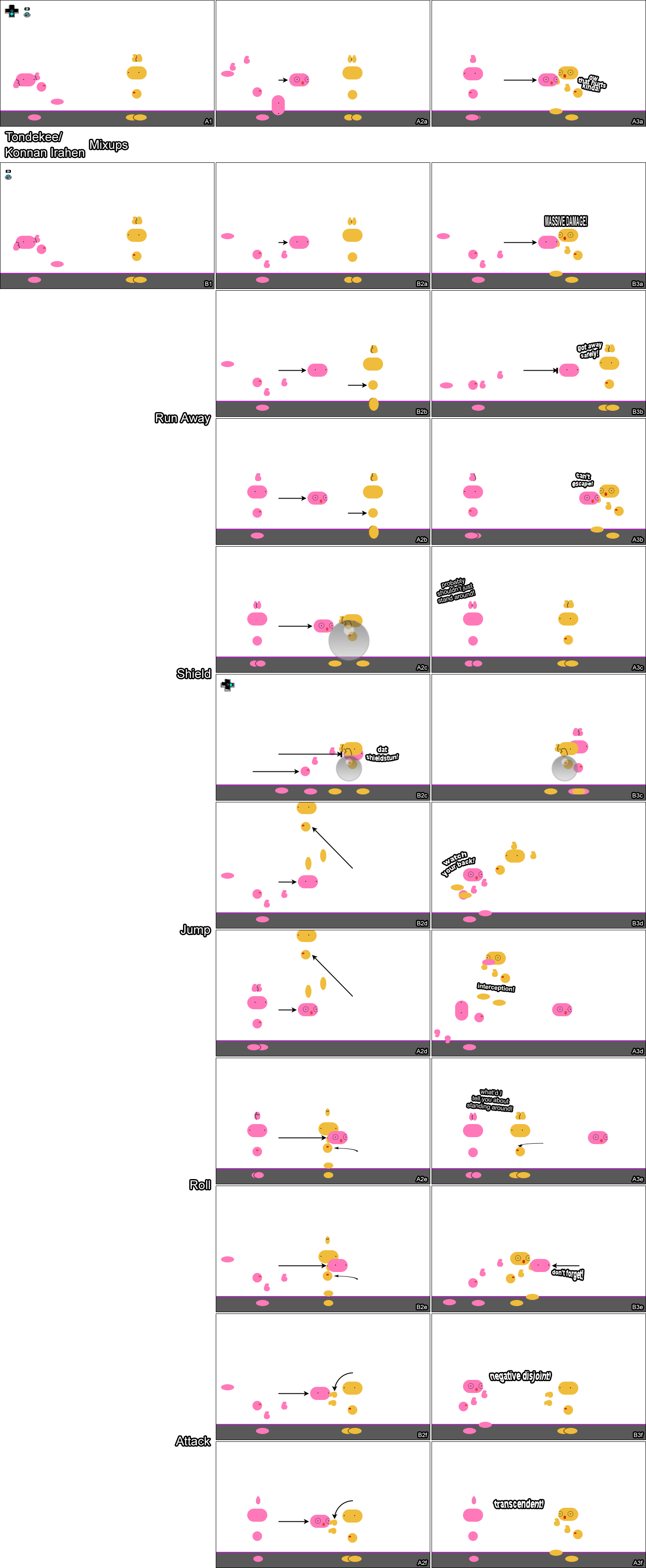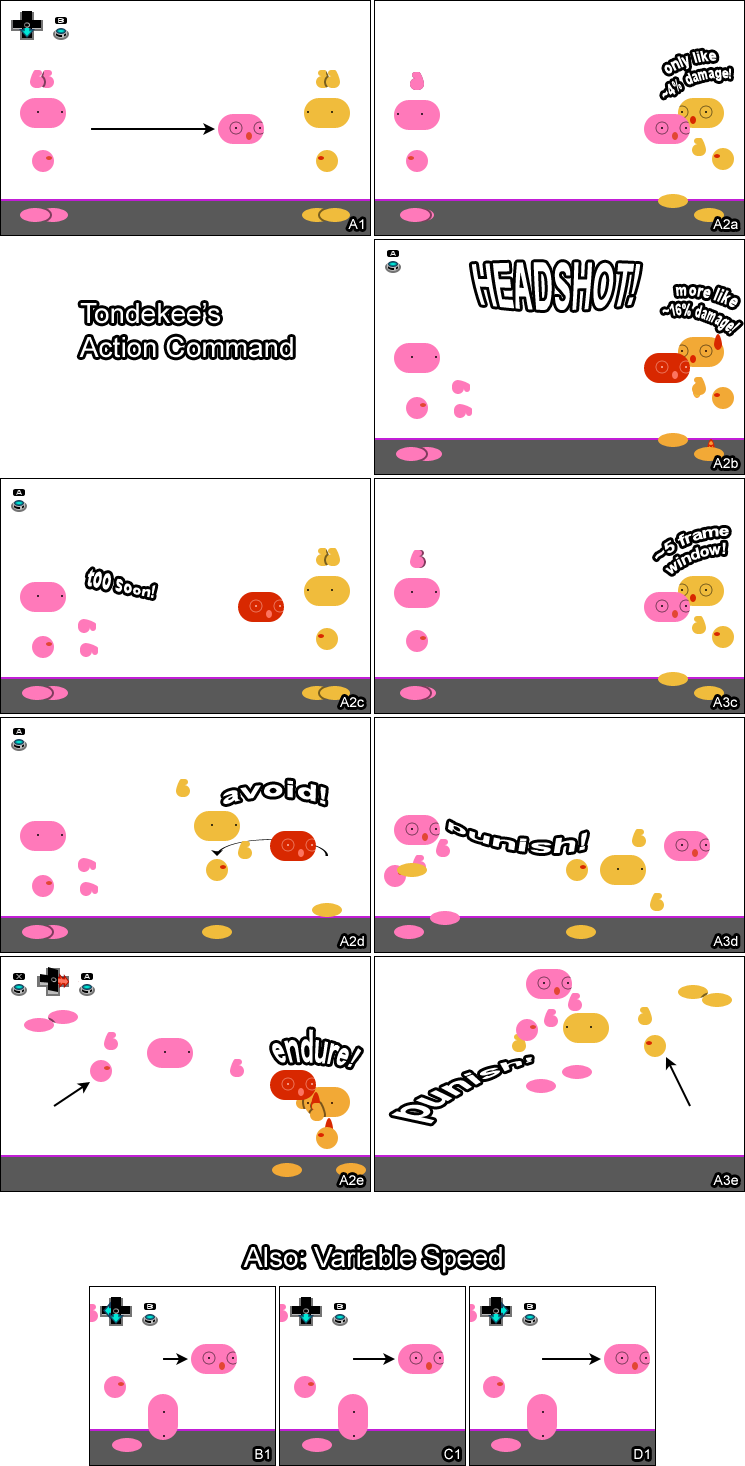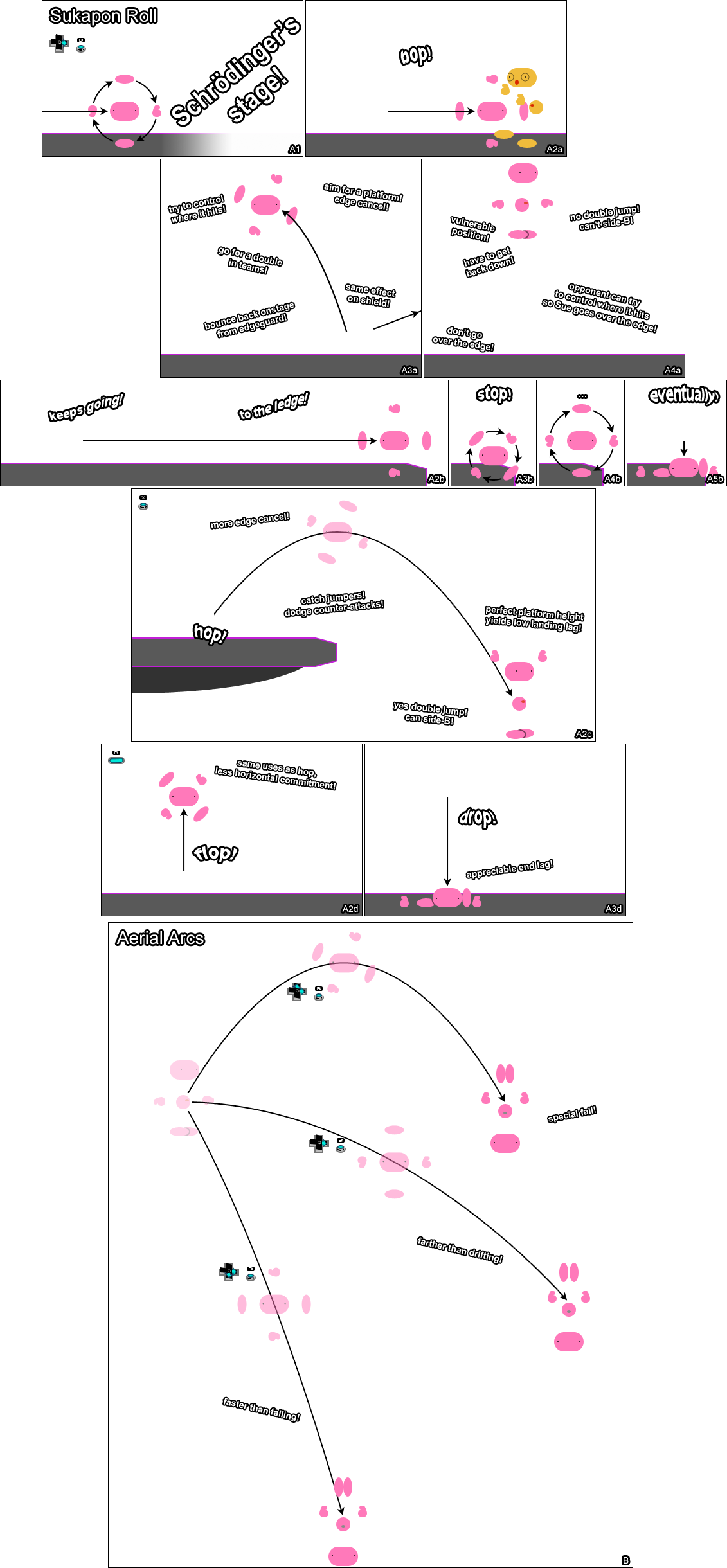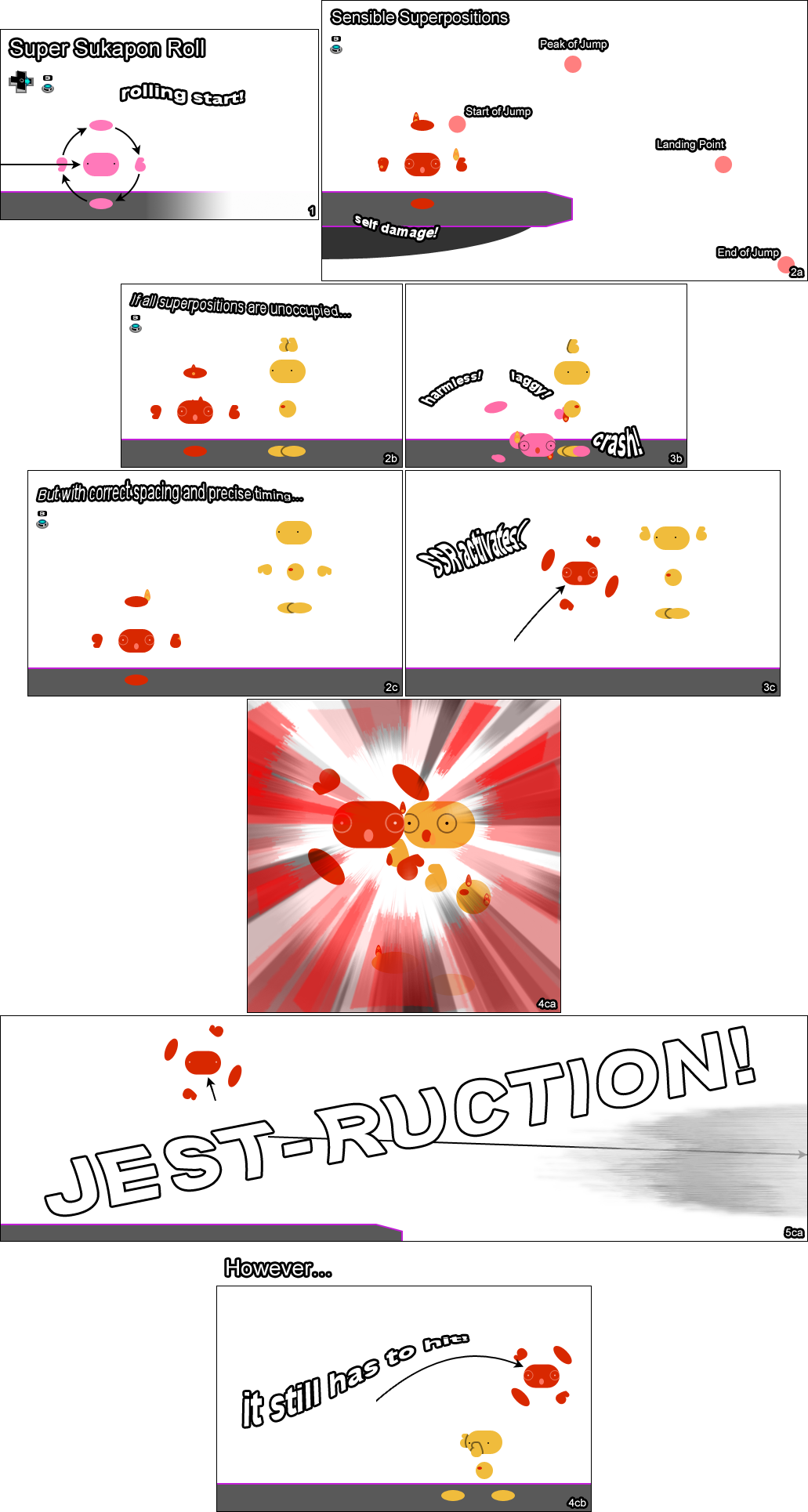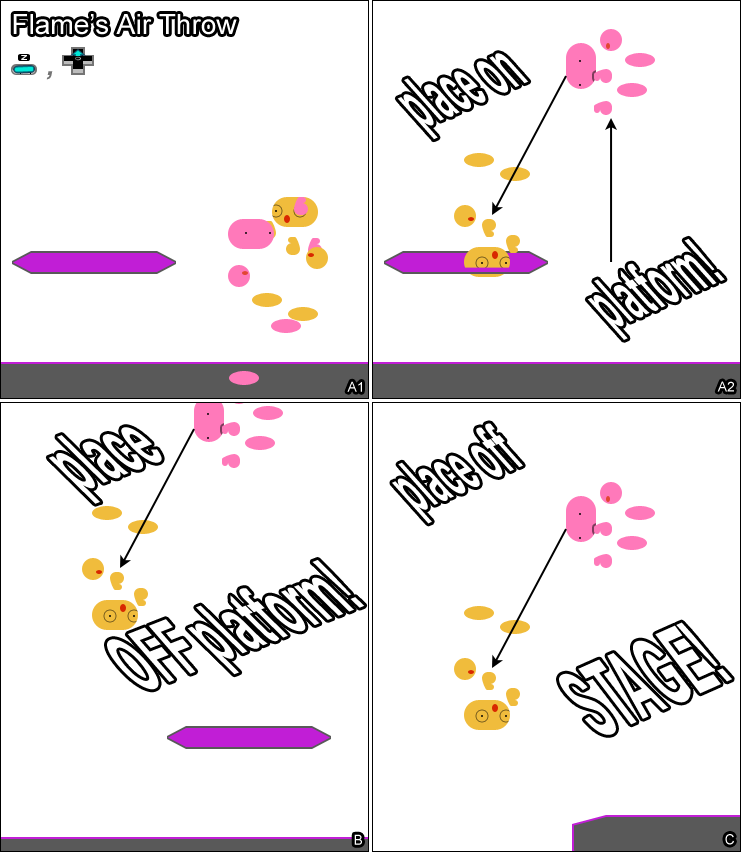My
+1 votes go to:
Sukapon
Waluigi
Ridley
King K. Rool
+1/2
Pig Ganon
Paper Mario
What is a Sukerponch and why should I care?
Sukapon (as spelt in Brawl, but can also be romanized "Skapon") is the main character of Joy Mech Fight, Nintendo’s first traditional fighting game, a respectable milestone worthy of Nintendo’s premier platform fighter. However, JMF was a late-Famicom Japan-only release, making Sukapon fairly obscure and unlikely to ever appear in any official capacity. But unfamiliarity should not be mistaken for unlikability; Sukapon has the potential for popularity.
A robot born from an explosion, Sukapon’s first act was to dance amongst its creators’ charred forms and ravaged lab. Sukapon’s dream was to become the world’s greatest stand-up comedian, but that dream was deferred when its co-creator Dr. Walnuts went rogue and hijacked military robots (visible below; those who bemoan Sukapon's appearance should check out how cool the characters of the represented game are). As the only thing that could stop Wil… excuse me… Walnuts’s mechs, Sukapon was reprogrammed to fight, yet never lost its joyful demeanor and humorous antics. After some deus ex machina, Walnuts returns to normal at the end of the game, and Sukapon goes on to fulfill its dream in a sequel that never came to be.
Surely, Sukapon sports something for anyone to love, if they only knew it existed. Nevertheless, Sukapon’s obscurity actually bestow some benefits. One of the great aspects of Smash for me, and probably many others, is how it brings to light much of Nintendo’s rich history that I never knew before. Like Marth or Ice Climbers, Sukapon serves as a prime candidate for that aspect. Having learned of a new, amiable character, people have a tendency to feel as if they have accessed some secret insider knowledge, and to find said character’s neglected underdog status endearing. For those thus afflicted by Sukapon’s charm, as I was and am, I direct you to reading materials
here and
here, and remark that acquiring access to JMF (with an English patch) is fairly simple and that there is a Game Genie code to get all characters without needing to unlock them.
Of course, lacking an organized fanbase, there may be less initial hype for Sukapon (although the results of this thread imply the opposite), but that's not something that's important in the long run, and usage results make it clear that what really matters is how good and fun a character is. On the other hand, it means Sukapon introduces a possibility no other character does: as the game's community and Sukapon's playerbase grows, Project M would be able to lay claim to the character as one that is solely its own. Knowing someone's a fan of Sukapon would be enough to deduce that they're a fan of Pro.M, and that's
pretty cool.
Finally, for what it’s worth, Sukapon is a machine, and its gender-identity is not attested amongst the game-text and booklet. Thus, one choice is as arbitrary the other, so the PMBR could take initiative on that avenue and count Sukapon as another female character. All it would take is using "she" on the site, as is done for Ivysaur. To exemplify this point and clarify antecedents, I shall use be using “she.” After all, Sukapon
is a
Japanese robot, suggesting she is female. Then again, she’s pink, which Captain Fabulous, PimpUigi, and American Box Art Kirby testify is the manliest of colors…
NO SUKAPON THOSE ARE HUMAN ROOMS DONT GO IN THERE YOU ARE ROBOT THEY DONT EVEN FIT
Qualities
As a competitive game, the number one factor in considering what character to add should be what the character contributes to the gameplay. By my reckoning, Sukapon touts the most fun, unique, interesting, and deep characteristics of any nominated character, solely by virtue of her visual design. Long-ranged, yet with few disjoints; tall, yet with small hurtbox area. Sukapon allows moves comparable to a intensified Marth and toned-down Zelda Minus (a playstyle I greatly enjoyed), where attacks spaced too close yield not a sourspot, but a complete whiff. The potential such moves contain is amplified by the range of options available: attacks that extend from her body, passing both hitbox and hurtbox through the intervening space but leaving none behind, and attacks that utilize the third dimension to seemingly warp directly to the target; attacks which threaten wide, specifically shaped areas, and attacks that threaten precise points of space; attacks that linger, occupying space, and ephemeral attacks requiring practiced timing. This focus on spacing extends even to the opponent, as without proper aim attacks might pass right between Sukapon’s disjoint pieces. Through practiced understanding of Sukapon’s hurtboxes and other characters’ hitboxes, any of Sukapon’s movements could be used to avoid being hit, and an expert player could evade and counterattack in literally a single action.
Being designed around aiming would make her disproportionately effective against bigger targets, but this should be offset by such targets having bigger attacks, making it harder for Sue to slip through (or around) them. But there’s a more creative way to turn smallness into a weakness: attacks which have sweetpots nearby the higher-priority normal hitboxes in such a way that the sweetspot is in a tunnel, making it harder or impossible to hit larger enemies with only the sweetspot. For example, ground attacks with a sweetspot on the bottom, so only short enemies will be low enough; mid-range attacks with a sweetspot nearer Sukapon, so wide opponents won’t be able to fit between the attacking piece and the rest of her body; a sweetspot on her head and torso during Eye Copter, so Sukapon must thread the needle of herself with her opponent; and a sweetspot on Sukapon’s torso during Triple Somersault, so to land it she must begin next to an enemy and encircle them with her extremities.
And all this without any special coding, only a intuitive-yet-unexplored usage of Smash's most basic systems, resulting in a legitimate playstyle, rather than gimmick. But that’s not to say there aren’t other, more elaborate mechanics available to her. The importance of natural dodges to her may conduce an anti-crouch, whereby the player can hold up to change Sukapon's stance so it can avoid low attacks. She flaps her arms while jumping, a fair excuse for a flutter jump. A need for precision and a talent to about-face may combine in a double jump that she can use to turn around, yet
not to DJC. Her origin might inspire a more traditional “block” as opposed to Smash’s “shield,” or even a hybrid system. JMF heals a character when they take a stock, so that could be carried over. Some projectiles have a Mario RPG-esque Action Command that increases their strength if the player presses A as they hit, so that could be referenced. Mechs fall apart at the end of a match, so she could drop body pieces as items. Plus any other twists JMF provides the genre of which I am unaware, but might lurk in the above links.
Animations
The only ability that I’m aware is pertinent and is essential to Sukapon is a single projectile, so the .rel donor seems a fairly open choice. So is animation donor. Sukapon could mix and match from multiple characters, but the most fitting character overall is Peach. Except for specials, the Princess would be perfect if Sukapon is to be entirely a cloned from a single character. Luigi and Olimar are also good matches, and Zamus, Wario, or Kirby
might be workable. The only custom animations truly essential to Sukapon are Tondekee/Konnan Irahen and Sukapon Roll, and the only major cosmetic ones are twirling idle/walk and flapping jump/fall.
But the more Sukapon's Smash instance is to implement her individual identity (ideally, a lot), the more custom animations would be needed. However, I’d wager those animations would be more simple, straightforward, and significant than for other characters. In JMF, Sukapon moves in a somewhat Brawl-Wario-esque manner, animations consisting of certain parts remaining static while others move along geometric paths, sometimes to points at which they stop, wait, then reverse. Combine this with her lack of pesky anatomy to preserve and one should have the freedom to take a lackadaisical approach to any custom animations, where pieces are plainly placed into the proper poses, and tweens allowed to do the rest, without even requiring the hand of the dedicated animators (besides any cleanup). Maybe some bobbing of otherwise static pieces to make them more natural. This would make reversing animations relatively easy, and since Sukapon is a robot with pieces that float (and thus needn't balance), the reversed animations would be less likely to look weird.
Mewtwo's file shows new bones can be added, so Sukapon could be given a maximal bone structure (plus an extra one to allow independent rotation of her torso), allowing her to take any pose from nearly any character in the game, without even necessarily needing to be re-proportioned since she
has no proportions, and with unused bones simply retracted. Thus radial motions (epicycles within epicycles!) could be created by moving, over a single frame when the time comes, an ethereal bone to the motions' center and moving the next-distal bone so that the body-piece is back in place, then rotating the center as necessary, then reverting everything to normal when it's over. Maybe messy, but still possible. Additionally, a large portion of animations are generic enough that they wouldn't really stand out against an otherwise stop-start-centric moveset whether they were completely ripped from another character or not. Things like using ladders, hanging from edges, or being held in a grab just don't have much room for being unique.
There are also creative concepts that could cut corners if creating cool custom animations is the chosen course, such as: reusing the same pose for prone, supine, and tripped, as well as the associated getups; a squashed version of her standard idle/walking/jab animation for carrying/throwing heavy items; making use of how, in JMF, a couple of Sukapon's attacks begin as a normal attack which she then flubs; the different speeds of walk being hardly distinguishable; forward and backward versions of jumps/falls just having different piece-alignments; just lowering the upper body of shielding to make crouching; using her twirling idle animation as a base for all swimming related things; using Sukapon Roll for all her rolls; minimal or absent turning animations; attacks while armed with a battering weapon using the same animation as the unarmed version; etc.. Dependent on model, such trivialities as the difference between left & right hands and feet, left & right sides of parts, and tops & bottoms of parts might even be ignored, as well as not needing to deal with fingers, tails, hair, or clothes.
As for the what of custom animation, Joy Mech Fight illustrates a fair selection of Sukapon’s moveset and movements, not to mention the possibility of referencing other JMF bots’ moves, and of course, being a robotic comedian beyond physical limitation leaves plenty of room for creativity, and Sukapon’s sprites deliver an excellent medium for communicating ideas.
For a unique trait, rather than rolling to get up, Sukapon could just pull herself together at a different piece.
Stats
While inevitably a precision-based spacing character, the approach to the archetype is fairly open. Besides the obvious long reach and large size (taking JMF’s cartoonish proportions at face value, Sukapon is at least eight feet tall), the only stat essential to her characterization is her slow walk (and backwalk of equal speed, whereas it’s slower for most characters. Not entirely relevant in Smash, but could be represented by instantaneous turnarounds.). Her dash might be an only-slightly-quicker version of her twirling walk, or the ballerina impression might be supplemented by agile grand jetés putting those long lack-of-legs to use to dash
over attacks (in contrast to Marth/Shiek/etc. dashing
under). Her hand-flapping might be an effective method of slowing descent, or it might be a comedic juxtaposition with how prompty she reaches terminal velocity. She might have low aerial mobility since traditional fighters have none, or she might have high aerial mobility since JMF broke the mold and gave some. She might be light due to all the empty space, or she might be heavy due to being made of metal. As a fighting robot, she might have powerful attacks, or, as a robot not initially designed to fight she might have weak attacks. She might have high max fallspeed, or she might have low max fallspeed. She might have good tech-rolls, she might have bad tech rolls. Might have high traction, might have low traction. Long jumpsquat, short jumpsquat. Big shield, small shield. And on and on. Her expected “feel” just isn’t very established, so there’s free rein to do whatever works on pretty much everything.
Difficulties
The development of Sukapon does have some plausible pitfalls and roadblocks that I can foresee, but I also have what I hope are workable solutions to whatever impediments there may be.
The game may not lend itself well to discerning – without visual indication of their relative position – whether pieces that are far from the rest of Sukapon’s body are aligned in the plane of play and thus viable targets; for such situations, graying-out might work as a good indication of when a piece is outside the range of most hitboxes, and animations can be altered to minimize time spent in troublesome positions. Players may have difficulty keeping track of Sukapon’s individually free-floating pieces; adding a soft glow or a sword trail should make her stand out more. While Sukapon avoiding moves by doing absolutely nothing sounds cool on paper, in practice it may turn out to be less of a test of skill and more of a test of temper, with hits and misses on Sukapon feeling random even when she’s in hitstun; the sizes of her pieces relative to their separation and hurtboxes may be adjusted to make success more reliable.
One might think attacks slipping through Sukapon's disconnected pieces (moreso, failing to do such) would highlight the fact that there's not a one-to-one correspondence between hitboxes and models; while deemphasizing that facet of the character (as mentioned above) is an option, it's really no different from any other character getting hit despite visually ducking under, jumping over, side-stepping, or out-spacing an attack, and (as with the other cases) the speed, GFX, and the sudden switch to a "damaged" state should hide any discrepancies. Players may find it jarring when they out-prioritize Sukapon’s hand while it’s five feet away and her body suddenly goes flying, or when they grab it and she’s teleported to them; experienced Smashers should hopefully not think it so strange what with the presence of things like Marth’s telekinesis, magnet ledge-grabs, Pikachu’s Up-B, hookshotting opponents behind you, and exceptional SDI, for which sound-, haptic-, and graphical-effects all go a long way towards readability, but if it truly becomes a nuisance then conferring intangibility to pieces at times when they are particularly far from the rest of the body should fix it.
Some custom animations, such as getting up after good punch, might look weird due to the illusion of unity amongst Sukapon's pieces, despite technically being possible because they are free-floating entities; this might be solved by adding a little jet graphic. There’s also the possibility that custom animations end up looking
too stiff and jagged without adequate attention to detail, or that keeping the tempo and speed of movements consistent is unexpectedly exacting; scaling up the degree to which cloned animations are used, from just in incidental actions to general movement and even up to normal attacks, would resolve that issue.
Example Moveset
Very high acceleration and deceleration horizontally and vertically in air and on ground, with instantaneous turning animations and low short hop, means Sukapon has the control for precise hits, and gives what is effectively an infinite-range dash dance despite having no initial dash animation, but slow max speed limit its effectiveness and encourages using non-movement moves to avoid attacks. Combined with low full jump, high double jump, and low terminal velocity, her ability to navigate the stage by traditional means is limited. Her specials cater additional mobility to shore this weakness, but each has its own drawbacks and limitations.
Normals: Primarily a mid-range fighter, with attacks tending to be somewhat farther than in JMF, but has enough variety that some are closer than Sheik's arms and others farther than Zamus's whip. Attacks taken from JMF also tend to be re-envisioned to either lack hitboxes until near their maximum range, or to pass through the third dimension to reach their target. This leaves a blindspot near her, so opponents can actually avoid her attacks altogether by getting right up close. Since those are still pieces of her body that she's sticking out there, not actual weapons, they carry the standard risks of non-disjointed attacks.
JMF-Sukapon's Punch becomes PM-Sukapon's jab: a weak close-range attack that is one of her very few options for hitting enemies who are in her face. Kick becomes u-tilt. Both Aerial Kick and Aerial Punch could be any of fair, nair, and dair, and they give the impression of sex-kick properties. For variety's sake though, one could be a Doc-like sex-kick, or the attacking piece(s) could spin on one to make it a multihit.
It's hard to tell at full speed, but frame-by-frame one can notice that Sukapon's Sweep Kick and Good Punch both begin with a more traditional attack that Sukapon then flubs. Making use of this, the time before screwing up could be prolonged to be more noticeable, then two separate attacks could be made from one (thus cutting down on custom animations): one where she follows through correctly (which could be taken from another character), and one where she falls down. The correct Sweep Kick as d-tilt with the flub as d-smash (with hitboxes on her hands and feet both), and the correct Good Punch as dash-grab with the flub as dash attack. This method could be expanded upon, with Sukapon Toss as b-throw and a flubbed version as d-throw, throwing an item being a bungled battering-attack, and a premature release making the difference between an upward and downward item-toss.
The other Joy Mechs' movesets contain quite a few remarkable and recognizable (to those who've played) attacks to use, even if not all as attacks. Some simply require rotations or just have a couple poses, while others are quite complicated and not really worth the effort, but I've thrown them all up just in case it's inspiring. The first few also evoke some fresh new gameplay elements:
[collapse="Dancing Robots"]
GIFs cannot play in 60 fps, so you may need to get Animated PNG support for your browser to display these.
Giant's Dash Straight makes a good f-smash. Since its JMF input involves holding backwards, Giant's backwalk could be the charging animation, which fits with the focus on aim and natural dodges as the player uses the move to space itself.
Flame's Air Throw as u-throw, capable of meteoring offstage less situationally than Fox/Charizard/G&W's d-throws, as well as of placing opponents onto/off of platforms. Contrasts with the rest of the moveset in demanding proper spacing not to hit, but to hit
in the right place.
There are plenty of other throws in JMF, so I won't mention them all.
Eye Copter, as a nair or uair, would be the first aerial that's bipartite like Link's f-smash. The first portion could act as a multihit, while the second is a strong hit, so the player can control when the opponent is released (barring SDI), but requiring timing to maximize the first portion's damage without going past the second portion's activation-window and into endlag, leaving the opponent nearby with little hitstun. The JMF move also provides a slight hop when used, which could be translated to the first/second/both portions of the Smash version, again conforming to the emphasis on natural dodges. The picture above demonstrates the second portion being activated at different times: not at all, immediately, upon descending, and just before landing.
Also it has a cool sound.
Skater's Triple Somersault would be a distinctive nair or uair. The lengthy duration and multiple attacking pieces gives plenty of room for a complex move with diverse hitbox properties based on timing. The pose is also basically a more centralized version of Sukapon's Jump Kick.
Alternatively, Sue could substitute her hands for Skater's tires (hitting only with her feet and head) and use it as a ground attack, such as u-smash. Come to think of it, she could perform the attacks of robots that have more pieces by ejecting pieces from a compartment in her head or torso, or even splitting a piece into separate pieces.
Sukapokon's Nonsense as a rapid jab is obvious. Functions as a sort of desperation attack, just resulting in punishment in most occasions, but punishment which – if the move was used well – is more desirable than whatever Nonsense interrupted.
Very fast to come out (even able to cancel jab's startup and come out before jab would) and covering a large area (thus not needing precision), but slow to end, leaving plenty angles open, with weak hitboxes that refresh too slowly to keep the opponent in hitstun and that can even occasionally miss simply by virtue of being too chaotic.
Senju's Kick looks almost as silly as the things Sukapon does, and could be an f-tilt if it were more horizontal. Of course, a precision-based character would need angleable f-smash and f-tilt, and maybe even other tilts, smashes, aerials, or even grabs. Sukapon's a great choice for such abilities since posture isn't an issue, and it would facilitate more options for natural-dodging.
Though, with such freedom in attacking, there would need to be something to keep spacing thoughtful and skillful, rather than changing gameplay into simply pointing and clicking. Variance in more than solely damage and knockback would help, such as in range, l-cancel timing, and ancillary movements. The attacks themselves could also be built around this issue by striking more involved areas than just outward in the given direction (such as the pieces going lower on the angled side of d-smash and higher on the other, which would also add depth with underside-sweetspots), or by being long-lasting with small hitboxes so Sukapon is left wide open if she angles poorly.
Hover's Good Punch for a fairly laggy, long-ranged, spacing-dependent grab.
Flame's Fire Fury/Gel's Invisibility could be Sukapon's Assist Trophy activation pose, with the Trophy placed on her foot or head. The first pose could also be used for growing with the second for shrinking, and it could be reversed for teching in place.
A flailing headstand based on Grak's Reversekick would be a fitting getup attack for Sukapon.
Shenlong's Dragon Spin could be used for rolls, and Sky Dragon a ledge jump, but they look inappropriately brutal and majestic for actual attacks by Sukapon.
Superzak's Zak Kick, Legend's Heel Press, Star's Crash Back, and Hover's Meteor shot are all possibilities for interesting ledge attacks.
Bok Bok's Hurricanbok could be a ledge roll.
Ghoston's Ghost Dance looks like a >99% ledge roll, although it's at the forefront of the "pointlessly complicated" rank.
Star's Cannon Hit pose looks like a wall-tech-jump.
For attacks with battering weapons, Geo's leg sweep as jab, Skater's Spin Upper as dash attack, and Sasuku's good punch as smash (with the little flip as the charging animation) all stand out.
Garborg's Good Punch/Hammer Wave could work for tilt with battering weapons and for firing projectile weapons.
To get fancy, Sukapon's Hammer animation could be based off Dachon's Wild Dash or Ra's Spinning, or both with Wild Dash while moving and Spinning while idle. Wild Dash would also work for eating, and Spinning for teetering.
Houou's Hououcannon could be an item- or forward- throw, but it's another of the more detailed moves.
Also it has a cool sound.
Spurred by the end of Joy Mech Fight matches, I'm intrigued by the idea of Sukapon shutting down and decohering during certain animations where appropriate (such as tumbling and sleeping depicted above) with the pieces falling as a bunch of unrelated rocks. Of course, beyond just waiving the high clonability of such animations, that would necessitate verisimilar fall/bounce physics…
Related uses of Sukapon's design would be glitching out when paralyzed and blue-screening when stunned.
[/collapse]
However, I think it's important that Sukapon's comedic personality not be drowned out by standard combat-oriented actions. It's clear from Sukapon's playful and unorthodox animations that she was programmed to make people laugh, and that should be incorporated into new and borrowed animations when possible. In particular, most of her JMF actions – most prominently her kick, throw, and Tondekee – feature very quirky poses that look too painful and unbalanced for a human. She clearly likes showing that she's limb
er despite being limb
less.
 Specials:
Specials: Echoing Joy Mech Fight's creative use of individual sprites for different body pieces to achieve the record of smoothest Famicom graphics, Sukapon's specials express a kind of "versatility from simplicity." They are all common, simple special move types, with versatility afforded by a heap of branching options. Note that inputs were assigned to mimic the inputs of Joy Mech Fight.
Neutral-B, Konnan Irahen (Konaniran in the fan-translation, at 1:05 in the video). A just-plain-strong type attack. Sukapon's most powerful attack in JMF (besides a secret super). Start-up more greatly resembles Tondekee than does the JMF version. Sukapon throws her head forward as a powerful, yet vulnerable, long-range attack, then withdraws it. If the player is holding forward at the moment when she begins reeling in her head, her head instead remains stationary while her body is pulled forward. Thus the move can be used both defensively to control space, and offensively to approach. To better fit with Smash’s (particularly PM's) style, she may need to be able to act sooner out of it than in JMF, or to continue holding forward at the end to be slingshotted forth. With that adjustment, it could be followed-up and used for both recovery and on-stage movement.
Additional tricks have been installed since Walnuts’s attack. Holding B can momentarily prolong her head at max range. By holding down when her head is first released, it instead does a little circle under her torso and back to its proper place (similar to Dachon's Limb Spin), catching those who expected to bypass a thrown head and attack her helpless body, and overall being faster than the normal input-less attack. Holding up at that same moment does the same thing, except with an upward path, rather than downward. Finally, holding backwards at release completely reverses the move: Her head remains stationary (still with the hitbox, though) while her body slides backwards, then is withdrawn back to its starting point. But of course, continuing to hold back instead withdraws her head. If all this somehow doesn't sound degeneratively flexible, but does make the move have too little commitment, the time for making all relevant decisions could instead be during startup.
In Joy Mech Fight, Konnan Irahen could not be used in the air, so what happens is without precedent. That she continues to fall, head and body, just as normal for most attacks is the obvious answer, but not the only one. Perhaps her head is thrown at an angle? Angles? Perhaps she halts in midair throughout the attack? Perhaps she can't drift during the move, so using it is not always optimal when close to the stage? Perhaps her head becomes an independent article and moves as a projectile would, then boomerangs to wherever her body ended up (or vice versa)? Likewise, when her head hits a wall or floor, the obvious result would be for it to ignore and pass through them, as other moves do; but it could instead cause her to bounce away, perhaps leading to some new AT's.
Also, maybe there could be some sort of "clash" mechanic if two of them hit eachother, since it is a
KI blast…
Down-B, Tondekee (Tondeker, 0:22). A projectile type attack. Startup more greatly resembles KI than does the JMF version. Rather than throwing her actual head as for KI, a duplicate appears at the moment of release. Sukapon has downloaded some tricks from her fellow mechs, so now Tondekee can be made stronger if the player presses A right when it hits an opponent, which of course must be used wisely since Sukapon herself will also respond to that input. Holding forward or backward at release increases or decreases the speed of the head, and because this is Smash, she has the added trick that the choice of speed is analogue. To make the mix up with KI a more useful risk/reward for both parties, KI has negative disjoint, while Tondekee is transcendent for the first second or so.
Side-B, Sukapon Roll (0:52). A momentum-affecting type attack. That momentum can be a useful surprise for opponents expecting more of Sukapon’s slow movements, but carries the downside of having no great way to stop besides getting a kill (or sweetspotting the ledge, if she’s off-stage). Most reminiscent of Wario’s Shoulder Charge, in that it can’t turn around and doesn't penetrate opponents, but still very different. Much weaker, no max range, stops progressing for a second at an edge or wall before ending, and on hit flings Sukapon far upwards and away from the opponent while retaining its hitbox then ends when she starts to fall, without her double-jump or the ability to SR again until touching ground (or being hit, for the later). Combined, this leaves a miss vulnerable to counterattack, and an opponent can even intentionally allow themself (or their shield) to be hit to bounce Sukapon off-stage. Can also be angled 60° up or down at the start (aiming the aerial version is a new trick, as is the downward grounded one, which is only useful when teetering). Supplies the same momentum when used in the air, but is parabolized by gravity, and goes into special fall after a while. Jumping during the ground version goes into an special mode much like Shoulder Charge does, but which can’t be double-jumped out of, only ending after hitting the ground (or a while after it would have hit the ground if it goes over an edge). Pressing shield during it does a little hop its own height, much like when hitting with Rollout, but retains the hitbox. In any case, landing has its share of lag.
The Wheel of Fate is Turning…!
A super version is available in Joy Mech Fight, where the only regulation on its usage is the difficulty of its input. With spacing out sweetspots being Smash’s answer to traditional fighters' command inputs, and with all the emphasis on precision, Super Sukapon Roll is translated into an attack much like Rest or Luigi’s Up-B. Usually, pressing B during a grounded Roll causes Sue to overheat and spinout, leaving her open. However, with the correct spacing, Sukapon will jump just as if jump had been pressed, but with a red glow, and if an opponent is struck (which is not guaranteed by "correct spacing") they are dealt a flaming killer blow. Unlike other moves currently in Smash, "correct spacing" is actually far in front of Sukapon: at the moment B is pressed, the opponent (or really, any hittable hurtbox) must be along the arc through which Sukapon subsequently will fly (or, if she's being affected by wind or something, how she would fly if she weren't). Or, if that makes it too easy, instead of the full arc it could be restricted to one or more of the following spots ("Superpositions," if you will): the apex of the arc, the landing point of the arc, directly in front of Sukapon, or the point at which the move ends if it goes over an edge. To further discourage spam, it could come with the cost of self-damage like Eye's A-Strong, regardless of whether it hits or even sweetspots; in this case, "Comikaze" would be an amusing name.
Up-B, Jibber Arm (Named after a robot that has the attacks Thunder Arm and Arm Vulcan). Not based on a type of attack, but on the act of grabbing a ledge. JMF’s Sukapon has run out of specials at this point (besides one that’s just a throw, not to say Sukapon Toss couldn’t be turned into a tether recovery quite similar to this one, although it probably couldn’t be since no character has both a tether and a command throw), and while there are viable Up-B candidates in other mechs’ movesets, I thought this idea was too cool not to mention. From what I understand of ledge-grabbing – that it’s based on boxes around the character – this might even be possible (although, from what I understand of ledge-grabbing – that it’s stubbornly coded and still not completely straightened out – it’s probably not).
Some point in the animation. Full length? Half length? ⅔? Iunno, whatever's balanced.
In the air, Sukapon stretches out her hands either vertically or horizontally depending on player input. This alters her ledgegrab boxes, allowing her to grab the ledge from far away. Actually a fairly lousy recovery. Not a tether, so it does not grab occupied ledges and it must be properly aimed. Her hands have no hitboxes, but do have hurtboxes, so she’s defenseless if an opponent attacks instead of getting the easy edgehog, and knockback received begins at her body, closer to the blastzone. Thus, KI, SR, and airdodging would be the usual recourses. Although, when not being edge guarded (such as after being launched across the stage or when going out for her own edgeguards) it becomes a fast and safe option. On-stage it could be used for retreating (or advancing) to the ledge, for grabbing it out from ledge campers, and for her own games when progressing from ledge to stage. While edgeguarding, the downward hand allows her to cover a high recovery while retaining a method to quickly edgehog low recoveries or chase onstage landings, and on the flip side she can take advantage of other characters’ inaptitude at covering both options. The move simply ends if her hands touch any surface.
Alternatively, if that variant isn't feasible, she could perhaps instead keep her hands together and bind her ledgegrab boxes to them. The vertical/horizontal branch would then instead be up/down/left/right, or possibly even finer directional control.
On the ground, is a weapon-type move. Sukapon hastily reaches out in a straight line with invincible (not intangible) hands in any single chosen direction, dealing as minor damage and knockback as Falco’s lasers. The longer B is held, the farther they reach, but the endlag increases exponentially. A very circumstantial utility move, obvious uses include absorbing beefy projectiles, eating enemies’ double jumps and charges, tapping Resting or special-falling teammates from a distance, harassing enemies near the top blastzone, hitting platform campers, and popping balloons.
Alternatively, rather than possessing a hitbox through the duration of the extension, it could behave akin to PK Flash, so she spreads out her hands as if for a hug then claps them together when B is released, or they are greyed-out until circular-sawing when B is released.
Miscellaneous
Select Stage. Press Start.
For a change of pace, Joy Mech Fight actually doesn’t have all that much going for it in regards to a series symbol. The more notable options that I can think of are depicted above, and described below.
[collapse="The Meaning of Stock"]
- A sprue with JMF’s Japanese acronym, based off of the logo; I think it’s one of the better options, but it’s kinda complex, and I prefer series symbols to be entirely pictorial.
- A plate based on JMF’s HUD, since this will be going on a HUD; it’s a cute idea, but doesn’t represent JMF very well.
- Sue’s face based off the character select screen; as a fighting game, the CSS is seen frequently, and Sukapon is the main character of Joy Mech Fight and someone I’d like to play in PM, but it’s not that interesting, and using a picture of the character always struck me as a copout.
- Dr. Little Ermin’s head, the mechs’ co-creator; he appears throughout the story mode, giving tips and advancing the action, but he’s not too recognizable.
- Sukapon being created in JMF's opening; kinda complex (although could have certain aspects changed or omitted), not too important, and features the character herself.
- The mic used by Sukapon as a comedian; although character-specific rather than series-encompassing, it fits right in with symbols like Kid Icarus's and Fire Emblem's, and could have the stand shortened or cropped so that its dimensions are more equal, thus I think it's another of the better options.
- A torn diagram based on one seen in the lab in the story's opening; vague enough to not be any particular robot, yet presents the characters' fundamental body structure, but it might not be too recognizable as a poster, and if only the schematic then it's kinda bland.
- A chip Ermin places on the first few mechs to turn them to his side; an important plot element, but hard to recognize when two-tone.
- From a screen in the background of an arena where several of the fights take place,
- From a screen in the background of an arena where several of the fights take place.
- From a screen in the background of an arena where several of the fights take place. It is, I think, the best choice. It's simple, recognizable, and although not descriptive of the gameplay (besides the first boss being a bird), it's certainly descriptive of tone, so it could make for a weird little thing that makes sense to those who've played, kinda like Ice Climber's eggplant.
- A machine based on the title screen; could be trimmed down to decrease complexity, and although used nowhere else in the game, the squiggliness is appropriate.
[/collapse]
For alternate colors, Sukapon could have decals and even robobits based on the other mechs. Note that, for some odd reason, it seems as if there are two different versions of the game’s palettes, the main difference being that where one has a yellow-orange, the other has a yellow-green. To compare these, see the two in the lower right corner: it's the same palette viewed on two different emulators.
Much better than MY robot costume from Halloween.
I personally find Joy Mech Fight’s sounds really entertaining. If there aren't enough, existing ones could just be modulated, but if there’s anyone on the team with the expertise, I imagine screwing with a Famicom soundchip to create imitation effects could be fun. Laughter is a must for inclusion in Sukapon's cheer.
Joy Mech Fight already furnishes an entrance, victory animation, and victory theme. Other victory animations could be the hatching sequence at the top of the post, and parodies of other characters' which she screws up or exagerates. The standup show during the credits exhibits perfect material for taunts.
Of course, these could be reused in other custom animations.
There are several directions to go with Sukapon’s model. It could be a direct copy of the one featured on JMF’s cover, or it could be a more accurate rendering of the sprites and artwork. The design could be kept minimal, or it could get a modern overhaul, the only limit to detail being the human imagination (and several other things that are less uplifting). I personally think a more conservative model based on the sprites would be best; after all, the complex designs of the other robots in JMF show that the creators
intended for Sukapon to look as she does.
I actually really like the idea of how this face works, but it comes at a considerable cost of simplicity and cuteness.
Her Kirby hat could comprise one or more of the following: no cheeks, vacant mile-long stare with those beady eyes, the red gem, removal of what little Kirby has in the way of arms and legs, or any extra details present in the model used.
Concept Art
[collapse="What Even am I Talking About?"]
More to come…
[/collapse]
In Conclusion
Sukapon has the pedigree, aesthetic distinctiveness, player support, and cloneability to stand out as an excellent clone engine candidate. She offers a playstyle, physics, and design much more compelling than just "like this other character but stronger/faster/floatier/somethinger", yet does so without relying on disruptive gimmicks that redefine interactions, instead using the game's fundamentals in a new – but natural – way. Her specials boast traits that are simple to understand but rife with strategic depth and which no other character can replicate: the role of Konnan Irahen as both a movement- and zoning-option; the timing and tradeoff of using Tondekee's action command; the mindgames of KI/Tondekee mixups; and the long-range sweetspot of Super Sukapon Roll that still isn't sufficient to secure a successful snipe on the sought subject. Finally, an exclusive out-of-game opportunity is attainable with Joy Mech Fight and Sukapon. Much like the Smash series has done with Ice Climber and Captain Falcon, PM has the chance to establish the game and character as products of its own dissemination. Whenever you see a Joy Mech Fight fanwork – be it comic, video, image, prose, game, or just a casual reference – you could infer that the creator shares an interest in Project M.
Thanks for reading what I have to say about the character I’d most like to see, the one character that I’d definitely personally main. I know I can be verbose on topics that engage me, but I’m glad you persevered. I hope you found this post informative and convincing, or at least entertaining. Please feel free to point out any mistakes.
 Thanks, you've been a wonderful audience! Goodnight!
Thanks, you've been a wonderful audience! Goodnight!












































